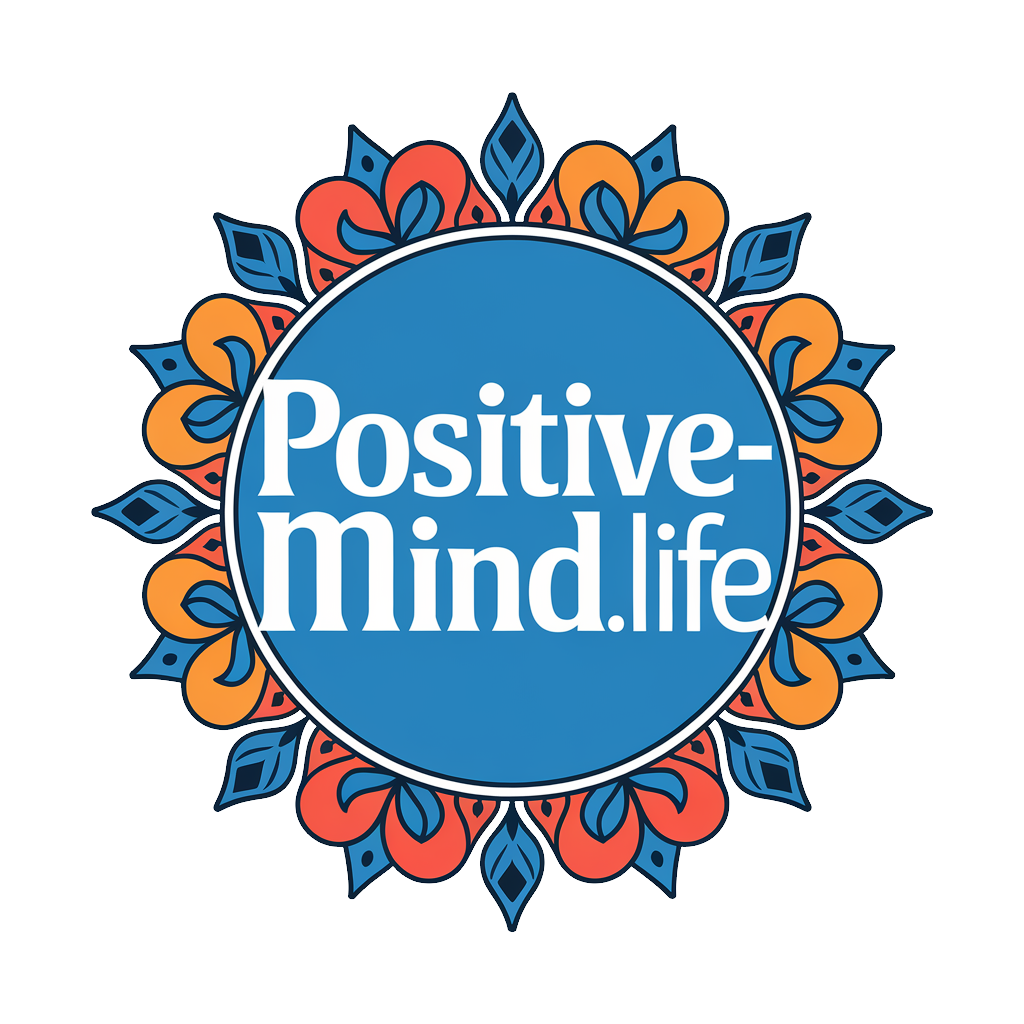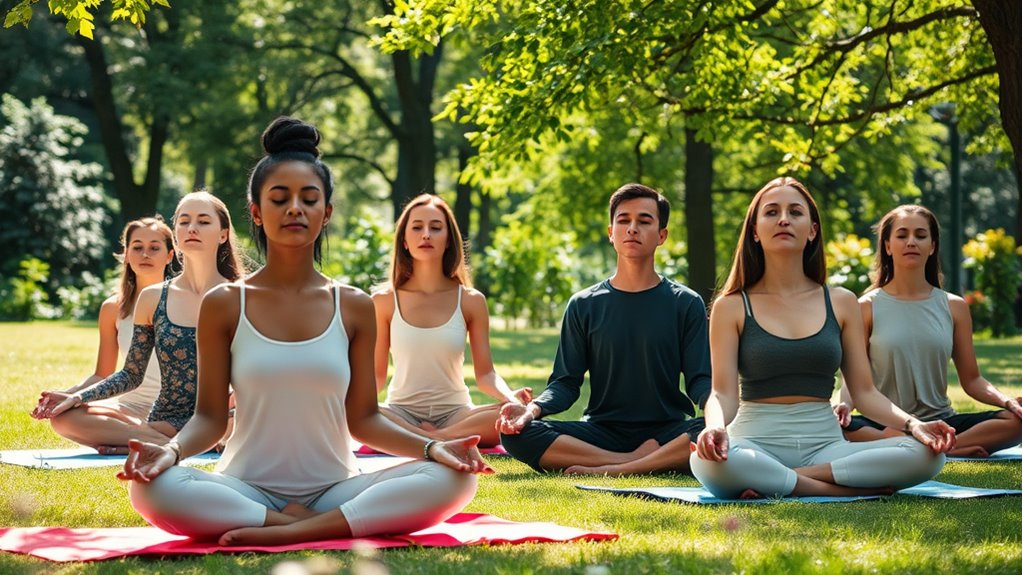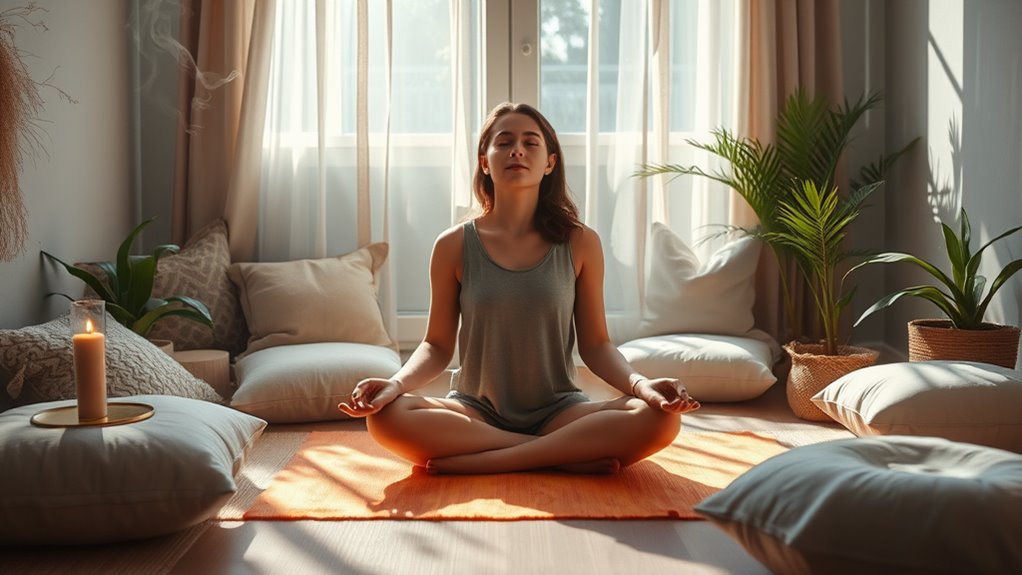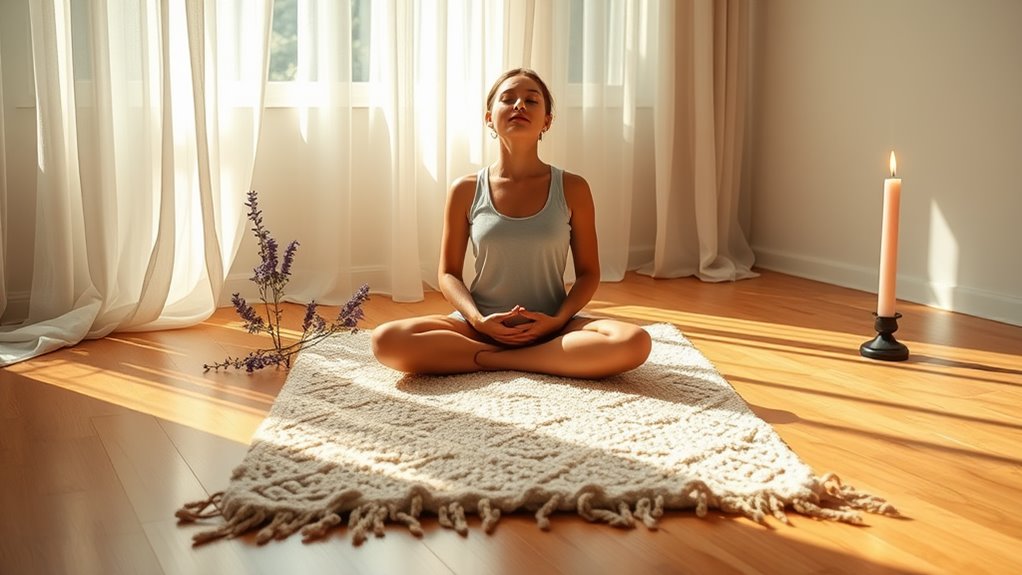10 Guided Meditation Techniques Perfect for Beginners!
If you’re starting your meditation journey, try these ten guided techniques to reap the benefits. Begin with the Body Scan Meditation to explore bodily sensations, or use the Breath Awareness Technique to anchor yourself in the moment. Loving-Kindness Meditation cultivates compassion, while Guided Visualization offers a peaceful escape. You can also repeat a mantra to center your thoughts or enjoy Progressive Muscle Relaxation to relieve tension. Mindful Walking engages your senses, and the Five Senses Exercise fosters present-moment awareness. Short Mindfulness Breaks can refresh your day. Keep going, and you’ll discover even more techniques that fit your personal style!
Key Takeaways
- Guided Visualization offers a mental escape, using imagery to promote relaxation and focus, ideal for beginners seeking calmness.
- Loving-Kindness Meditation encourages compassion and self-acceptance, providing a gentle introduction to emotional connection and mindfulness.
- Mantra Repetition helps beginners anchor their thoughts, reducing distractions and fostering positive change through simple, resonant phrases.
- Mindful Walking combines movement with breath awareness, making it accessible and engaging for those new to meditation practices.
- Five Senses Exercise enhances present-moment awareness by engaging all senses, making it a practical and effective technique for beginners.
Body Scan Meditation
Body scan meditation is a powerful technique that invites you to explore the sensations in your body, helping to cultivate awareness and relaxation. By engaging in this practice, you’ll develop a deeper sense of body awareness, which can enhance your overall well-being. Begin by finding a comfortable position, either lying down or seated, and close your eyes. As you settle in, take a moment to notice your breath and the sensations around you.
Start at the top of your head and gradually move your attention down through your body, focusing on each part and noticing any tension or discomfort. You might find it helpful to silently acknowledge these sensations, allowing them to exist without judgment. This method serves as one of the most effective relaxation techniques, as it encourages you to connect with your physical self.
As you practice regularly, you’ll notice how body scan meditation can bring a sense of calmness and clarity. It’s not just about relaxation; it’s also a powerful tool for self-discovery. With each session, you’ll become more attuned to your body’s needs and responses, paving the way for greater self-mastery.
Breath Awareness Technique
Breath awareness is a powerful tool that helps you connect with the present moment and calm your mind. By practicing basic breathing techniques, you can enhance your focus and create a sense of inner peace. Let’s explore some tips that will make your breath awareness practice even more effective.
Importance of Breath Awareness
Mindfulness thrives on the simple yet profound practice of breath awareness. By focusing on your breath, you anchor yourself in the present moment, allowing distractions to fade away. This practice isn’t just about inhaling and exhaling; it’s about cultivating a deeper connection to your body and mind.
You can enhance your breath awareness through techniques like breath counting. As you breathe in, count “one,” and as you exhale, count “two.” Continue this until you reach five, then start over. This method helps to sharpen your concentration and maintain your focus, making your meditation more effective.
Mindful inhalation is also crucial. As you inhale, visualize the air filling your lungs, nourishing your body. This awareness transforms a simple breath into a revitalizing experience.
Basic Breathing Techniques
Building on the foundation of breath awareness, mastering basic breathing techniques can significantly enhance your meditation practice. Two essential techniques to incorporate are deep breathing and diaphragmatic breathing. These methods not only ground you but also help you tap into a deeper sense of calm and presence.
Here’s how to practice these techniques effectively:
-
Deep Breathing: Inhale slowly through your nose, filling your lungs completely. Hold for a moment, then gently exhale through your mouth. This helps lower your heart rate and reduces stress.
-
Diaphragmatic Breathing: Place one hand on your chest and the other on your abdomen. Inhale deeply, ensuring your diaphragm expands (the hand on your abdomen should rise more than the one on your chest). This technique enhances oxygen flow and promotes relaxation.
-
Consistency: Aim to practice these techniques regularly. Even a few minutes daily can make a remarkable difference in your overall well-being.
Tips for Focused Practice
Often, focusing on your breath can transform your meditation experience into a more profound practice. By embracing the Breath Awareness Technique, you can enhance your focus techniques and improve distraction management, allowing for a deeper connection within yourself.
Here are some practical tips to guide you:
| Step | Action | Benefits |
|---|---|---|
| 1 | Find a quiet space | Reduces external distractions |
| 2 | Sit comfortably | Promotes relaxation |
| 3 | Close your eyes and breathe deeply | Enhances awareness of breath |
| 4 | Count your breaths (1 to 10) | Improves focus and concentration |
As you breathe in, feel the air filling your lungs; as you exhale, let go of any tension. If your mind wanders, gently bring your focus back to your breath. This practice not only cultivates mindfulness but also strengthens your ability to manage distractions effectively. Remember, consistency is key. The more you practice, the easier it becomes to maintain your focus. Embrace the journey, and enjoy the calm that comes with each breath.
Loving-Kindness Meditation
Embracing the practice of Loving-Kindness Meditation can profoundly enhance your emotional well-being. This technique encourages you to cultivate feelings of love and compassion, not just for yourself but also for others. By repeating loving kindness phrases, you create a positive mindset that radiates outward. Here’s how you can get started:
- Begin with Yourself: Silently repeat phrases like “May I be happy, may I be healthy, may I be safe.” This sets the foundation for self-acceptance.
- Expand to Loved Ones: Gradually include close friends and family in your intentions. For example, say, “May you be happy, may you be healthy, may you be safe.”
- Extend to Others: Finally, broaden your circle to include acquaintances and even those you find challenging. This is essential for true compassion cultivation.
Integrating these loving kindness phrases into your meditation practice can transform your perspective. With consistent practice, you’ll notice a shift in how you relate to yourself and others, fostering an environment of kindness and empathy. So, take a deep breath and let your heart open to the beauty of Loving-Kindness Meditation!
Guided Visualization
Guided Visualization is a powerful technique that allows you to create mental images that inspire relaxation and focus. This method employs guided imagery to help you tap into your imagination, promoting a serene mental state. As you engage in visualization exercises, you’re invited to picture calming scenes, like a tranquil beach or a lush forest. These vivid images can transport you away from stress and anxiety.
To start, find a comfortable position and close your eyes. Take a few deep breaths, allowing yourself to settle into the moment. Then, listen to a guided visualization or create your own mental imagery. Picture the details: the colors, sounds, and sensations of the scene. This process not only enhances relaxation but also sharpens your ability to concentrate and achieve your goals.
With practice, you’ll notice that your mind becomes more adept at conjuring these peaceful images. Guided visualization can serve as a daily retreat, helping you cultivate a sense of calm and clarity. Embrace this technique, and discover how it can transform your meditation practice and everyday life.
Mantra Repetition
After exploring the calming practice of Guided Visualization, you might find that incorporating Mantra Repetition can further enhance your meditation experience. This technique involves selecting a phrase or word that resonates deeply with you, repeating it mentally or aloud during your sessions. The right mantra can shift your focus and create a profound sense of peace.
Here are a few benefits of mantra repetition:
- Focus: It helps anchor your mind, reducing distractions and enhancing concentration.
- Calmness: Repeating a mantra can lower stress levels and promote a tranquil state of mind.
- Empowerment: The right mantra can inspire motivation and positive change in your life.
When it comes to mantra selection, choose a phrase that feels authentic to you—something that embodies your goals or intentions. This personal connection amplifies the mantra benefits, making your meditation sessions more impactful. Remember, it’s not about perfection; it’s about presence. As you practice, you’ll likely discover a deeper connection with your mantra, enriching your overall meditation journey. Embrace this powerful tool, and watch as it transforms your experience into one of clarity and peace.
Nature Sounds Meditation
Nature sounds meditation can transform your practice by connecting you to the calming rhythms of the natural world. You’ll discover how these soothing sounds can enhance relaxation and reduce stress, making it easier to focus during your sessions. Let’s explore some simple ways to incorporate nature sounds into your meditation routine.
Benefits of Nature Sounds
Listening to the soothing sounds of nature can transform your meditation experience into a deeply calming journey. When you immerse yourself in these natural soundscapes, you can tap into profound benefits that enhance your practice. Nature sounds facilitate a connection to the environment, promoting a sense of peace and grounding.
Here are some key benefits of incorporating nature sounds into your meditation:
- Stress Reduction: The gentle rustling of leaves or the rhythmic sound of rain can lower cortisol levels, helping you to unwind and release tension.
- Enhanced Focus: Nature sounds create a serene backdrop that minimizes distractions, allowing you to concentrate on your breath and inner thoughts.
- Sound Healing: Engaging with these harmonious frequencies can promote healing on both physical and emotional levels, rejuvenating your spirit.
How to Practice
Often, practicing nature sounds meditation can be a refreshing way to deepen your mindfulness journey. Begin by finding a quiet space where you can relax without interruptions. Sit comfortably in a meditation posture, ensuring your back is straight and your body is relaxed. You might choose to sit on a cushion, chair, or even lie down—whatever feels best for you.
Once you’re settled, close your eyes and take a few deep breaths. Start tuning into the nature sounds around you, whether it’s the gentle rustle of leaves, birds chirping, or the soothing sound of water flowing. Let these sounds wash over you, allowing them to ground you in the present moment.
As you immerse yourself in these natural sounds, focus on how they affect your mental clarity. Notice how your thoughts begin to quiet and your mind becomes clearer. If distractions arise, gently redirect your attention back to the sounds. Aim for a session of at least 10-15 minutes, gradually increasing the duration as you become more comfortable. With practice, you’ll find a deeper connection to both nature and your own inner peace.
Progressive Muscle Relaxation
Progressive Muscle Relaxation (PMR) is a powerful technique that can help you release tension and stress from your body. By focusing on tensing and then relaxing different muscle groups, you can effectively reduce muscle tension and tap into the relaxation benefits that come with it.
Here’s how you can get started with PMR:
- Find a comfortable position: Sit or lie down in a quiet space where you won’t be disturbed.
- Focus on each muscle group: Start from your toes and work your way up to your head, tensing each muscle for five seconds before relaxing it.
- Breathe deeply: Inhale slowly as you tense, and exhale as you release, allowing your body to feel lighter with each breath.
As you practice PMR, you’ll notice a profound sense of calm washing over you. This technique not only alleviates physical tension but also enhances your mental clarity. With regular practice, you’ll master this method and enjoy its lasting relaxation benefits, making it an invaluable tool in your stress management arsenal. Embrace the journey of relaxation, and watch your well-being flourish!
Mindful Walking
Mindful walking is a fantastic way to connect with your surroundings and enhance your overall well-being. As you walk, you’ll discover techniques that help you focus on the present moment, allowing you to appreciate the simple joys of movement. Let’s explore the benefits of this practice and how you can easily incorporate mindfulness into your daily strolls.
Benefits of Mindful Walking
Walking can be a powerful tool for enhancing your mental well-being. When you practice mindful walking, you engage in a grounding exercise that connects your mind and body. This simple yet profound practice allows you to immerse yourself in the present moment, promoting clarity and peace.
Here are some key benefits of mindful walking:
-
Improved Focus: As you take mindful steps, you train your mind to concentrate on the rhythm of your breath and the movement of your body, sharpening your focus on daily tasks.
-
Stress Reduction: Engaging in this practice can lower stress levels, as it encourages you to release tension and embrace tranquility during your walk.
-
Enhanced Creativity: Mindful walking can spark creativity. By freeing your mind from distractions, you allow new ideas to flow naturally.
Incorporating mindful walking into your daily routine can provide numerous mental health benefits. Whether you’re strolling through a park or navigating your neighborhood, these mindful steps can transform an ordinary walk into a rejuvenating experience. Embrace this practice and witness the positive changes in your mental clarity and emotional balance.
Techniques for Practicing Mindfulness
Stepping outside with intention can transform your walking routine into a powerful mindfulness practice. Begin by focusing on your breath as you take your first few steps. Notice the air filling your lungs and the rhythm it creates. This simple act of mindful breathing anchors you in the present moment.
As you walk, engage your sensory awareness. Pay attention to the sounds around you—the rustling leaves, birds singing, or the distant hum of traffic. Feel the ground beneath your feet, the texture of the path, and the temperature of the air on your skin. Let these sensations deepen your connection to your surroundings.
Consider incorporating mindful journaling after your walk. Write down your observations, emotions, and thoughts that arise during your practice. This reflection not only solidifies your experience but also enhances your understanding of your mindfulness journey.
With each stride, you cultivate a greater sense of presence and clarity. Embrace this opportunity to connect with yourself and the world around you. Remember, mindfulness isn’t about perfection; it’s about being present. So, lace up your shoes and step into the transformative power of mindful walking!
Five Senses Exercise
Engage your senses with the Five Senses Exercise, a powerful technique that grounds you in the present moment. This exercise enhances your sensory awareness and promotes mindful observation, allowing you to connect deeply with your surroundings.
To practice, find a quiet space and follow these steps:
- Sight: Look around and identify five things you can see. Notice colors, shapes, and textures.
- Sound: Listen for four distinct sounds. It could be the wind, distant chatter, or even your own breath.
- Touch: Feel three different textures. This could be the fabric of your clothing, the coolness of a surface, or the warmth of your hands.
Short Mindfulness Breaks
After tuning into your surroundings with the Five Senses Exercise, you might find it beneficial to introduce short mindfulness breaks into your daily routine. These breaks are simple yet powerful tools for enhancing your focus and promoting stress reduction.
To begin, carve out just a few minutes throughout your day—perhaps during a lunch break or after a meeting. During these moments, practice mindful breathing. Close your eyes, take a deep breath in through your nose, hold it for a few seconds, and then exhale slowly through your mouth. This practice not only calms your mind but also centers your thoughts.
As you breathe, pay attention to how your body feels. Notice any tension and consciously release it with each exhale. This can ground you and help clear away distractions, allowing you to return to tasks with renewed energy and clarity.
Incorporating these short mindfulness breaks regularly can foster a deeper sense of presence in your life. Over time, you’ll notice improvements in both your mental clarity and emotional resilience. Embrace these moments, and watch how they transform your daily experience.
Frequently Asked Questions
How Long Should I Meditate as a Beginner?
As a beginner, aim for 5 to 10 minutes of meditation duration. Gradually increase your time as you grow comfortable. Remember, consistency is key; small, regular sessions can lead to mastery. Enjoy the journey!
Can I Meditate Without Sitting Still?
Absolutely, you can meditate without sitting still! Try walking meditation or incorporating mindful movement into your routine. These practices help you cultivate awareness and presence while allowing your body to stay active and engaged.
What if I Can’t Quiet My Mind?
If you can’t quiet your mind, embrace the chaos. Use mindfulness techniques like deep breathing and observation. Acknowledge mental distractions, let them pass, and focus on your breath. You’re mastering your journey, one thought at a time.
Are There Any Specific Times Best for Meditation?
Yes, specific times enhance your meditation experience. Morning mindfulness sets a positive tone for your day, while evening relaxation helps you unwind. Choose what feels best for you, and enjoy the benefits of both.
Is It Normal to Feel Restless During Meditation?
Feeling restless during meditation’s as common as clouds in the sky. Restlessness reasons might include distractions or stress. By acknowledging these feelings and practicing focus, you’ll gradually overcome distractions and deepen your practice. Keep going!




